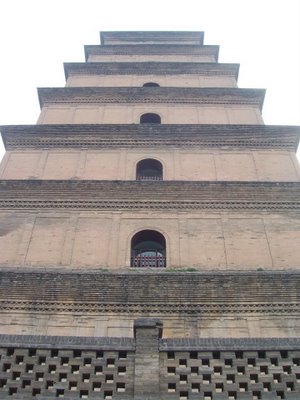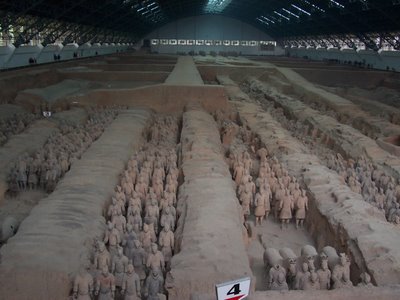This all gets horribly temporally contorted I'm afraid as this was drafted two days ago having written it originally last week!
------------
I'm finishing off the first day back at work which has been easier to get back into than I had expected, possibly helped by my finished caffeine hiatus (now resumed). Currently the sky is a browny yellowy red as the Gobi desert shifts a few degrees to descend on the city in another couple of millimeters of sand. The sky has a darkness, strangely eerie for this time of the evening.
Anyway, so we were up to Xi'an in jonsminitraveladventures and I seem to remember that I wrote this part of it on the boat on the Yangtze too where there was a reasonable amount of time to sit around and ponder as the sights floated past. At this point I'm foot massaged and ready to go...
---------
The next day was indeed a huge day of sightseeing led by a very good local guide who led us a merry dance through Xi'an's highlights. First stop was the Wild Goose Pagoda Temple which happened to be having an annual festival complete with monks chanting, waving incense and wandering around peacefully as the multitude of tourists took photos and videos and generally caused a commotion and the tour guides expounded loudly on the significance of the iconography.
The towering pagoda was begging to be climbed but time didn't allow on this occasion.
Monks monking as only monks can

Next we took the van to the 6000 year old village of Banpo, apparently a matriarchal society though the evidence for this fact appears to be on shaky ground at best. Wonderful reconstructions from seemingly simple ground plans and postholes leave me a little confused as to how accurate the extrapolations are but much of the pottery and tools from this 6000 year old agricultural society are extremely impressive. The crowning glory of their civilization is a water carrier rather like a Greek amphora but which tips cleverly in the water to fill up and then right itself automatically. Though it's a very ancient culture, from what I hear there are many more sites being found all over the world constantly pushing back the first known agricultural societies and this one is rather modern in comparison.
Onwards and upwards, we headed to the highlight of Xi'an. 2200 years ago emperor Qin enslaved 70,000 men for 38 years to build a terracotta army of ridiculous proportions in order to protect him in the next world. Only a small fraction of what is known to exist has been unearthed in the hope that in a decade or so archaeological techniques will have improved enough to preserve better the remaining sites (specifically the pigmentation on the statues which with current technology fades within a matter of hours of being exposed to the air). The largest site so far unearthed has around 6000 soldiers including archers, infantry and cavalry all organised in battle formation to protect the emperor. It's vast and it's impressive but somehow actually seeing it is only slightly more incredible to me than seeing the scale in pictures and reading the figures. I'm confused as to why this is but I suppose the point is that I was aware that it was enormous before I saw it and the actual tomb is exactly as I'd imagined. Saying that I would advise going to see it but don't expect it to exceed expectations (not that that makes much sense). 
One of the sites which hasn't been unearthed contains the bodies of the 70,000 men who built it in the first place who were sacrificed once it was completed. Nor has the emperor's tomb itself, a site of reputed monumental wealth with ceilings of marble, floors of bronze and a lake of mercury. When it is uncovered it will offer some spectacular, if toxic, historical treats.
One of the strangest spectacles at the site is to see the farmer who, when digging a well in the 70s, found the army in the first place (6ft off and he would have missed it completely). Now in his 70s he sits signing autographs for the masses, a bored expression on the face of a man who on the one hand discovered one of the greatest historical finds of the 20th century and on the other went from poor farmer to presumably rich and presumably confused national icon. It all feels like a bit of a circus and one wanders how much say he gets in his exploitation.
Lunch in the site restaurant was the usual gluttonous, glutinous affair and one of the members of the tour accidentally accepted a glass of snake wine mistaking the question for an offer of a cup of tea. Not being one to let things like this go to waste I thought I should give it a go, and, well it's OK. They sell it in my student shop but I shan't be rushing out to buy it any time soon.
A final trip to the hot springs (not for paddling in sadly) where the emperor bathed finished off an exhausting but fascinating day and our last full day in Xi'an, a lovely little city (with a paltry 5 million people).
The reflective springs with the hazy sunshine as we finished the tour
So, now we're in Chongqing where we flew, in rather turbulent conditions, from Xi'an this morning. We're now on the boat which will depart in the early hours of tomorrow morning on a three day journey down the Yangtze river. As people board this rather luxurious liner a brass band of simply execrable musicality blasts them on to the deck in raucous and tuneless fashion. It has to be said however that the crews enthusiasm is faultless as presumably they were not chosen for their tuba or drum playing skills as they were interviewed for the job.
It looks like it will be a fantastic three days seeing some of China's most exquisite scenery, some of which will disappear in the next three years due to the completion of the three gorges dam project. An interesting on board, pre-trip video weighed up in pretty unbiased fashion the pros and cons of this outlandish project. Almost half a million people died from floods from the Yangtze in the 20th century alone and the dam should put a stop to this natural phenomenon. In 1998 the floods cost around 30 billion dollars worth of damage. It will also produce around 10% of China's (current) electricity demands and in a country already choking itself to death on poor quality coal fire power stations (of which one is built every two weeks), this seems to be a huge incentive. Of course there is the flip side that many hundreds of thousands of people are losing their homes and being relocated, either further up the mountains or to the cities. Many don't want to move and a not insignificant number are left with worse housing than they had before. The cost to the landscape is also a heavy one as water levels rise around 150m in some places. There are also question marks about the fact that the dam is sitting on a fault line and it has been known for the weight of dams to cause earthquakes, a possible disaster of immense proportions. There are many other pros and cons but my gut instinct from hearing many opinions is that the project is a worthwhile one, saving many millions in the future from flood risk and producing such a great deal of clean electricity.
...and as the sun sets we get a great view of the Chongqing dock side before departing in a few hours time
---------
OK that, abruptly, will do for now but more to follow shortly.
Monday, April 17, 2006
Subscribe to:
Post Comments (Atom)
No comments:
Post a Comment